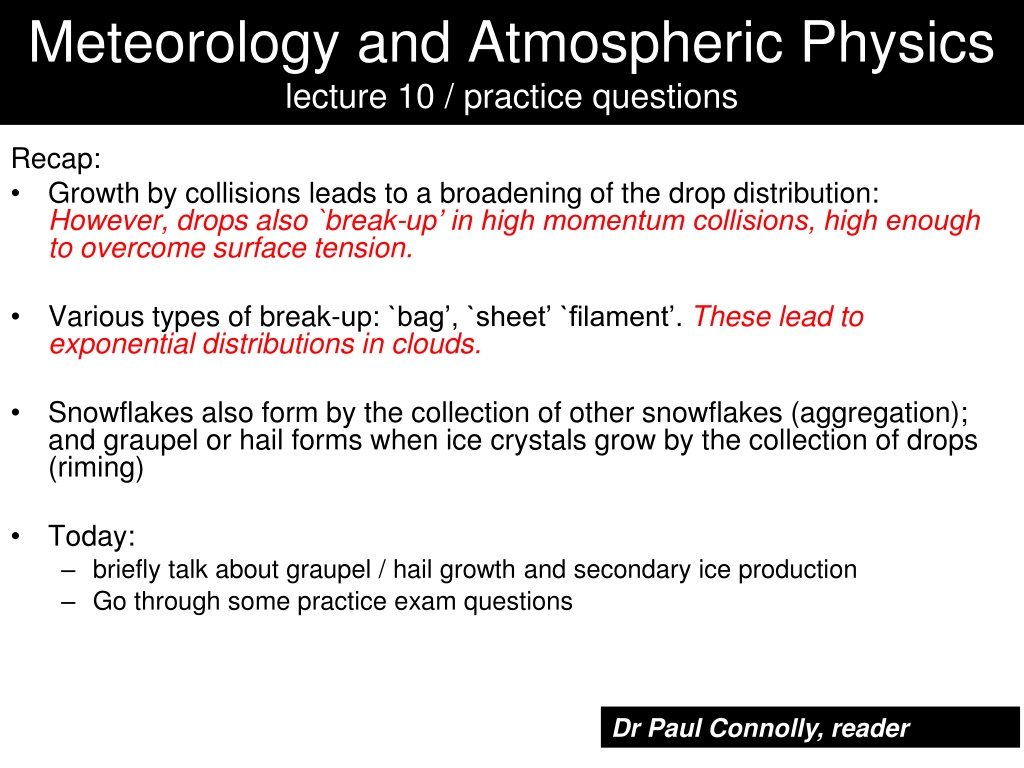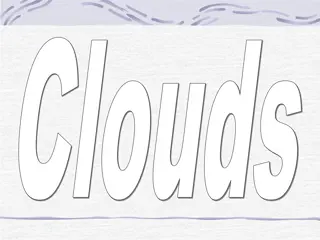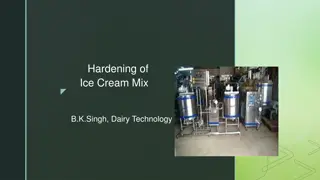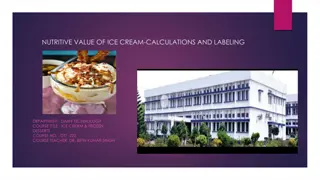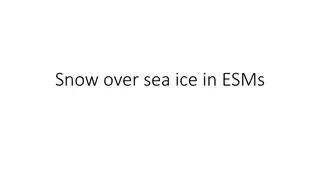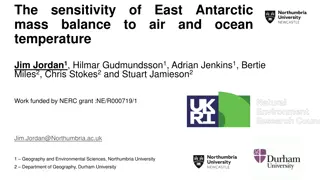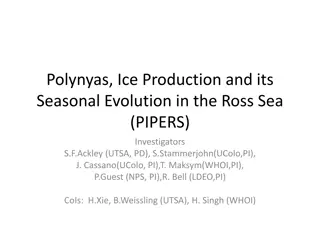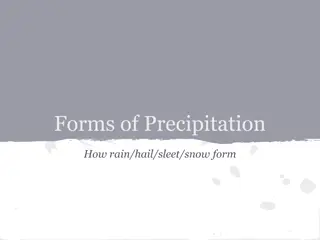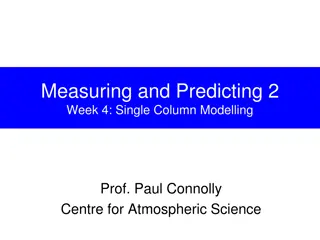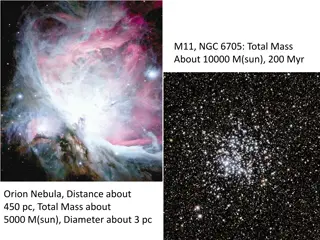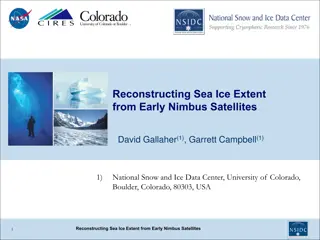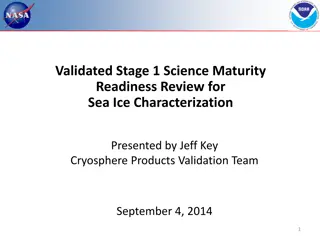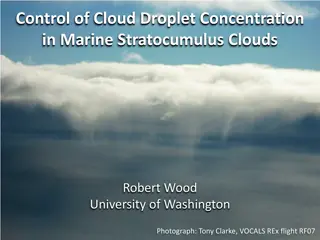Understanding Ice Formation and Growth in Clouds
Exploring the processes of ice formation and growth in clouds, including the role of collisions, break-up, aggregation, riming, and secondary ice production. Various factors influencing ice crystal concentrations and their interplay with ice nuclei are discussed. Images and data depict the relationship between ice multiplication, cloud top temperature, and secondary ice production in cold and warm cloud processes. Pioneering research by Hallett and Mossop on ice crystal formation is also highlighted.
Download Presentation

Please find below an Image/Link to download the presentation.
The content on the website is provided AS IS for your information and personal use only. It may not be sold, licensed, or shared on other websites without obtaining consent from the author. Download presentation by click this link. If you encounter any issues during the download, it is possible that the publisher has removed the file from their server.
E N D
Presentation Transcript
Meteorology and Atmospheric Physics lecture 10 / practice questions Recap: Growth by collisions leads to a broadening of the drop distribution: However, drops also `break-up in high momentum collisions, high enough to overcome surface tension. Various types of break-up: `bag , `sheet `filament . These lead to exponential distributions in clouds. Snowflakes also form by the collection of other snowflakes (aggregation); and graupel or hail forms when ice crystals grow by the collection of drops (riming) Today: briefly talk about graupel / hail growth and secondary ice production Go through some practice exam questions Dr Paul Connolly, reader
Ice Multiplication Sometimes there is reasonable agreement between the numbers of ice crystals and ice nuclei detected. For example, where ice crystal concentrations range up to 10 per litre in shallow stratocumulus and stratus with small droplets < 25 m, so there is no riming of the ice crystals. There is good agreement also in wintertime continental cumuli and cap clouds. All these cases of reasonable agreement between crystal and IN counts (to within x10) are in clouds with small droplets. But there are many clouds where crystals outnumber IN. The figure shown here is the result of ice nucleus and ice crystal measurements in cumulus clouds plotted against cloud top temperature. The Ice Enhancement Factor is the Crystal to IN ratio. Most crystals will be initiated at the coldest temperatures in the cloud - hence cloud top temperature is plotted in the graph. The ratio ranges from 1 at -20 C to 105 at -5 C.
Ice production/growth interplay in clouds Cold Cloud Processes Warm Cloud Processes Platnick
Where secondary ice production lies Cold Cloud Processes Warm Cloud Processes Platnick
First: you need ice and some droplets Cold Cloud Processes Warm Cloud Processes Platnick
Riming: key towards secondary ice Cold Cloud Processes Warm Cloud Processes Platnick
Secondary ice production Cold Cloud Processes -12 C Warm Cloud Processes Platnick
Pioneering work of Hallett & Mossop Cold room -4.5C 0.24cm 30cm 1.7m V<3 m/s 1.5m Hallett and Mossop 1974
Pioneering work of Hallett & Mossop Hallett and Mossop 1974 Mossop and Hallett (1974): production of splinters requires presence of droplets >25 m diameter. Splinter production is proportional to the rate at which these large droplets are collected.
Physical Mechanism for splinter production Rimer approaches liquid drop with diameter >25 m Choularton et al. 1978
Physical Mechanism for splinter production Rimer approaches liquid drop with diameter >25 m Rimer contacts liquid drop and they stick Choularton et al. 1978
Physical Mechanism for splinter production Rimer approaches liquid drop with diameter >25 m Rimer contacts liquid drop and they stick Ice shell forms Choularton et al. 1978
Physical Mechanism for splinter production Rimer approaches liquid drop with diameter >25 m Rimer contacts liquid drop and they stick Ice shell thickens and builds internal pressure Ice shell forms Choularton et al. 1978
Physical Mechanism for splinter production Rimer approaches liquid drop with diameter > 25 m Pressure relieved by cracking shell and ejected splinters Rimer contacts liquid drop and they stick Ice shell thickens and builds internal pressure Ice shell forms Choularton et al. 1978
Goldilocks zone for splinter production Droplets spread out when the hit the surface (Macklin and Payne 1967) don t form ice shell
Goldilocks zone for splinter production Droplets spread out when the hit the surface (Macklin and Payne 1967) don t form ice shell Ice shell too strong to break from internal pressure (Griggs and Choularton 1983)
Goldilocks zone for splinter production Temperature optimal for splinters Droplets spread out when the hit the surface (Macklin and Payne 1967) don t form ice shell Ice shell too strong to break from internal pressure (Griggs and Choularton 1983)
Goldilocks zone for splinter production Temperature optimal for splinters Droplets spread out when the hit the surface (Macklin and Payne 1967) don t form ice shell Ice shell too strong to break from internal pressure (Griggs and Choularton 1983) Dong and Hallett 1989 Suggest temperature gradient between drop and ice causes droplet fracturing in goldilocks zone, and this gets less effective at cold temperatures Dong and Hallett 1989 Suggest spreading due to wetting rather than kinetic energy
Visualization of the splintering process: New experiments: T.Leisner et al. Experimental Setup Ice particles aerosol generator + neutralizer DMA AC/DC power supply Droplet position Ultrafast Droplet injection Droplet sizing Video-Microscope Temperature control Humidity control Condensation Particle counter aerosol electrometer
Complete breakup -.12 ms 0 ms 1.4 ms 10.7 ms 867.14 ms 867.10 ms 699.8 ms 867.07 ms 867.23 ms 867.41 ms
Spicules and bubbles 0ms 0,39ms 0,51ms 1,0ms 1,36ms 1,87ms 16,06ms 286,03ms 372,1ms 490,59ms 601,19ms 640,1ms 655,07ms 657,99ms 656,51ms 656,56ms 656,94ms 657,8ms 657,88ms 657,95ms
Visualization of the splintering process: New experiments: T.Leisner et al. Results: Fragmentation frequency
In-situ aircraft observations Number of ice nuclei were measured to be ~10-2 L-1 at -10C
Warm rain is significant to the Hallett-Mossop process Model simulations from Crawford et al (ACP, 2012) Even 10-2 L-1 of ice nuclei can result in ~100 L-1 of ice crystals due to the H-M process Simulation without rain Simulation with rain The process of warm rain formation can be crucial to switching on the H-M process as it only takes a few rain drops to freeze and then they can fall through the cloud and collect liquid water. If this happens between -3 and -8C many ice splinters will be generated
Main points Ice crystal concentrations can be amplified by secondary ice production within cloud that contain pre-existing ice. We don't know all the mechanisms. One is the H-M process, which happens within a narrow temperature range, but can turn out to be very important for ice concentrations in the cloud. Warm rain is significant as it can lead to large hail stones very quickly. Good luck!
Ice nucleation Explain the ice nucleation modes clearly and concisely Explain any discrepancies between the measured IN and any other ice formation pathways, referencing any equations that describe the processes.
